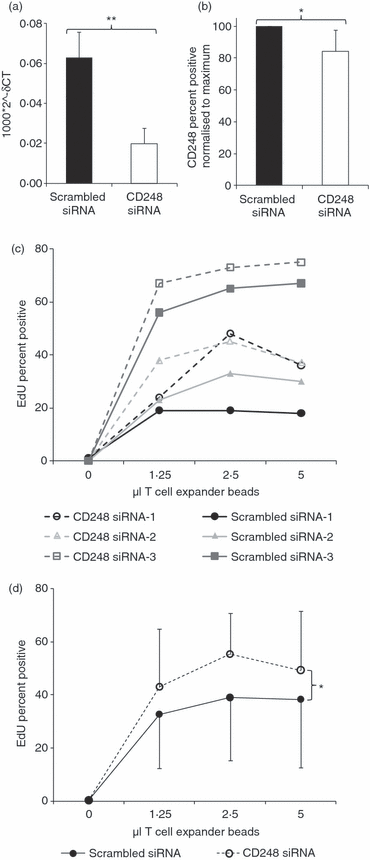The stromal cell antigen CD248 (endosialin) is expressed on naive CD8+ human T cells and regulates proliferation
- PMID: 21466550
- PMCID: PMC3108880
- DOI: 10.1111/j.1365-2567.2011.03437.x
The stromal cell antigen CD248 (endosialin) is expressed on naive CD8+ human T cells and regulates proliferation
Abstract
CD248 (endosialin) is a transmembrane glycoprotein that is dynamically expressed on pericytes and fibroblasts during tissue development, tumour neovascularization and inflammation. Its role in tissue remodelling is associated with increased stromal cell proliferation and migration. We show that CD248 is also uniquely expressed by human, but not mouse (C57BL/6), CD8(+) naive T cells. CD248 is found only on CD8(+) CCR7(+) CD11a(low) naive T cells and on CD8 single-positive T cells in the thymus. Transfection of the CD248 negative T-cell line MOLT-4 with CD248 cDNA surprisingly reduced cell proliferation. Knock-down of CD248 on naive CD8 T cells increased cell proliferation. These data demonstrate opposing functions for CD248 on haematopoietic (CD8(+)) versus stromal cells and suggests that CD248 helps to maintain naive CD8(+) human T cells in a quiescent state.
© 2011 The Authors. Immunology © 2011 Blackwell Publishing Ltd.
Figures






 ) exhibit higher EdU incorporation than scrambled siRNA-treated cells (
) exhibit higher EdU incorporation than scrambled siRNA-treated cells ( ). Data from three different donors are shown in (c) and the data are grouped in (d) showing CD248 siRNA treated naive CD8 T cells (
). Data from three different donors are shown in (c) and the data are grouped in (d) showing CD248 siRNA treated naive CD8 T cells ( ) exhibit significantly higher (*P < 0·05) EdU incorporation than scrambled siRNA-treated cells (
) exhibit significantly higher (*P < 0·05) EdU incorporation than scrambled siRNA-treated cells ( ). The Student's paired t-test was applied to compare the statistical significance of linked data. Error bars represent SEM.
). The Student's paired t-test was applied to compare the statistical significance of linked data. Error bars represent SEM.References
-
- Christian S, Ahorn H, Koehler A, et al. Molecular cloning and characterization of endosialin, a C-type lectin-like cell surface receptor of tumor endothelium. J Biol Chem. 2001;276:7408–14. - PubMed
-
- Greenlee MC, Sullivan SA, Bohlson SS. CD93 and related family members: their role in innate immunity. Curr Drug Targets. 2008;9:130–8. - PubMed
-
- St Croix B, Rago C, Velculescu V, et al. Genes expressed in human tumor endothelium. Science. 2000;289:1197–202. - PubMed
-
- Bagley RG, Honma N, Weber W, et al. Endosialin/TEM 1/CD248 is a pericyte marker of embryonic and tumor neovascularization. Microvasc Res. 2008;76:180–8. - PubMed
Publication types
MeSH terms
Substances
Grants and funding
LinkOut - more resources
Full Text Sources
Other Literature Sources
Molecular Biology Databases
Research Materials
Miscellaneous

